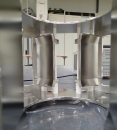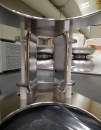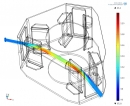↟ ELENA electrostatic transfer lines
ELENA (the Extra Low ENergy Antiproton ring) will use an electrostatic transfer line to distribute the antiproton beam among the experiments. I did the simulation and the design of these electrostatic elements, participated in the assembly, testing, installation and commissioning. Links to the documents (articles and engineering specs) will come sometime...
News
- 2020-12-11
- I have received the good news today from CERN, that the H- beam from the ion source passed through the longest electrostatic beamline to the ALPHA experiment. Remarkably, without any major tuning. The figures below show the beam profiles picked up by the SEM
beam profile monitor grids, and the beam observed by the MCP detector of ALPHA for the first time. The measurements are in very good agreement with previous similations and predictions.

Electrostatic deflectors
These devices contain two spherical electrodes to deflect the beam. At locations where the beamline splits towards two different experiments, these devices are combined with fast electrostatic deflectors (not shown in the images below) to serve as a quick switch, and send subsequent bunches of the same extraction towards different experiments, for more efficient sharing of the antiprotons.Images:




Electrostatic quadrupole doublet and corrector unit
These units contain two electrostatic quadrupoles with an aperture of 60 mm and length of 100 mm to focus the beam, and a horizontal and vertical electrostastic corrector to steer the beam.Images:

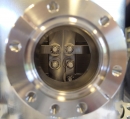

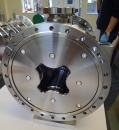









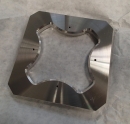
A multi-way ion switchyard
This device can inject H- ions and protons with a kinetic energy of 100 keV from a dedicated ion source into the ELENA ring in both direction, while it allows the undisturbed passage of the antiprotons coming from the Antiproton Decelerator at 5.3 MeV, and ejected from ELENA towards the experiments at 100 keV.Images:






